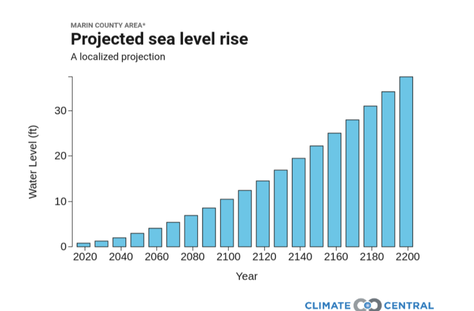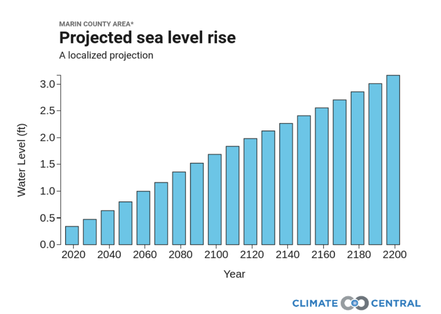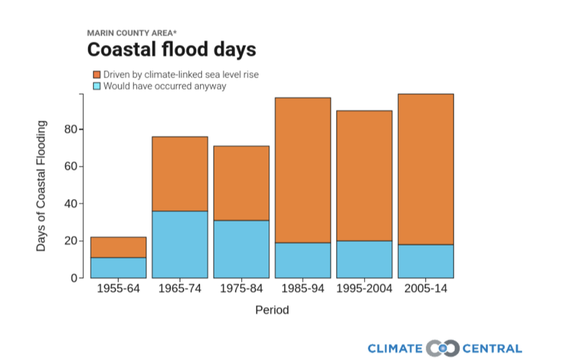Climate changes and the local environment:Over the past century, Marin County has experienced eight inches of sea level rise, and by 2100 could ultimately see an increase of 16.6 to 65.8 inches. Global sea level rise, prompted by increased concentrations of atmospheric greenhouse gases such as carbon dioxide, can be attributed to two main factors: Arctic ice caps are melting, and oceans are warming thus expanding in volume. The most extreme emission scenario, which represents the worst possible future scenario, projects a 4ºC increase in temperatures and a global sea level rise of 8.9 meters. If current global emissions are restricted and warming is limited to 1.5ºC, global sea levels are still projected to rise by 2.9 meters. Marin County’s location on the coast of California makes it highly susceptible to the impacts of global sea level rise. The projected increase in sea levels will threaten beaches and wetlands, introduce salt water to inland areas, and displace native coastal organisms. In Marin County, 13,774 acres of land have already been declared vulnerable to the threats of sea level rise. Rising sea levels will increase the frequency and intensity of flooding, and the damages will be worsened due to large coastal storms. These storms will also become more severe, as the warming atmosphere is capable of holding more moisture. California is especially prone to infrequent, intense rain events, and often receives the majority of its annual precipitation in only one or two large storms. Sea level rise, combined with more intense storms and floods, will fundamentally alter Marin County’s environment by accelerating erosion, introducing saltwater to inland environments, and drastically altering coastal species’ habitats. In some cases, rising tides will make a portion of the County disappear completely. How we know:These projections and reconstructions are based on freely accessible online tools from The National Oceanic and Atmospheric Administration (NOAA) Tides and Currents tool and the Climate Central Surging Seas: Risk Finder projections and tools. The NOAA Tides and Currents resource reports local mean sea level changes from 1850 to today. It uses data collected from U.S. and global water level stations to reconstruct local sea level trends. The Climate Central Surging Seas tool generates sea level projections based on the different emissions scenarios presented in the NOAA Technical Reports. This tool uses data from the San Francisco water level station to generate the coastal flood days graph. Human consequences:Rising sea levels and worsening floods will pose health threats to the residents of Marin County and may require citizens to relocate. Furthermore, it is likely these factors will compromise the County’s water quality. Occasionally, increased flooding could improve water quality due to water percolation through the soil; however, prolonged flooding more often stresses or over floods the soil, ultimately degrading water quality. With more frequent floods, salt water, excess nutrients from fertilizers, and sediment from erosion are expected to enter the groundwater in Marin County. In addition, the current storm water drainage will not be suited to handle more severe storms, causing flooding in the streets. This will also threaten human health, as it increases the risk that sewage systems will overflow and contaminate groundwater. Rising sea levels will also affect the properties in Marin County that are currently on the coast. In a lower emissions scenario projecting three feet of sea level rise, $4.2 billion worth of properties will be compromised. In an extreme emission scenario that forecasts 10 feet of sea level rise, property damages will reach nearly $9.3 billion. In 2016, the Public Policy Institute of California reported that one in five Californians lives in flood-prone areas. The costs to replace this vulnerable infrastructure could exceed $575 billion, as an increasing number of buildings will be in high-risk zones. As the effects of sea level rise and severe floods worsen in Marin County, residents and the local government must take steps to reduce current damages and to minimize future impacts. In response to increased flooding, Marin County has already widened creeks to reduce erosion, support higher water levels during floods, and restore wetlands. To combat sea level rise, Marin County has implemented structural defenses, such as floodwalls, levees, and tidal gates. Additionally, as the County recognizes that many future impacts cannot be mitigated, it promotes adaptive measures such as building elevated structures, relocation of at risk infrastructure, and planned retreats. The County’s website also includes an extensive action plan detailing flood prevention procedures and emergency protocols. As the impacts of severe floods and rising sea levels intensify, Marin County must continue to promote methods to mitigate and adapt to these changes. Further reading:California's Water. Public Policy Institute of California Flood Protection. Marin Watersheds Sea Level Rise. Marin Watersheds Article author: Esther Doerr, Georgetown University
Article editor: Maddie Bowen, Georgetown University
2 Comments
Kinsey Krebill
3/2/2021 05:15:25 pm
I am from Sacramento CA and I knew about the flooding but I did not know about the rising sea levels. How bad do you believe native species will suffer if salt water mixes with freshwater sources? What ways could California prevent the two water sources from intermixing?
Reply
Leave a Reply. |





 RSS Feed
RSS Feed